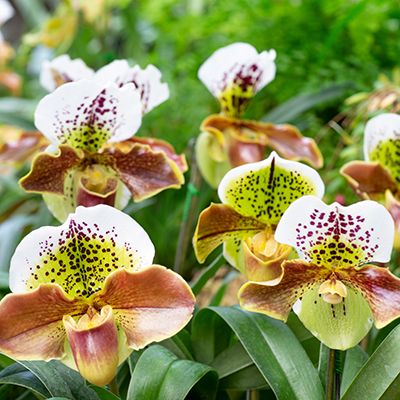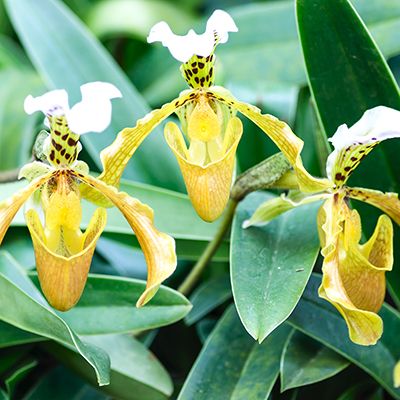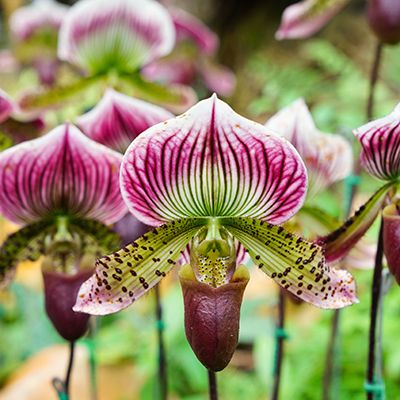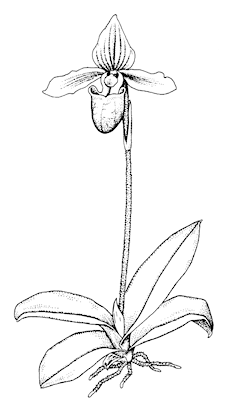


Paphiopedilum Orchids
 Paphiopedilums, the Lady’s Slipper Orchids, originate in the jungles of the Far East, including Indonesia. They are semi-terrestrial, growing in humus and other material on the forest floor, on cliffs in pockets of humus and occasionally in trees. They are easy to grow in the home, under lights or in the greenhouse.
Paphiopedilums, the Lady’s Slipper Orchids, originate in the jungles of the Far East, including Indonesia. They are semi-terrestrial, growing in humus and other material on the forest floor, on cliffs in pockets of humus and occasionally in trees. They are easy to grow in the home, under lights or in the greenhouse.
LIGHT is easier to provide for Paphiopedilums than many other types of Orchids. They require shady conditions, as in the home in an east or west window, or near a shaded south window. In the green house, shade must be provided. In the home, fluorescent lighting is excellent; suspend two or four tubes 6 to12 inches above the leaves.
TEMPERATURES for Paphiopedilums cover a considerable range. Paphiopedilums are traditionally separated into two groups: the warm-growing mottled-leaved types and the cool-growing green-leaved types. A third, increasingly popular group is the warmer-growing strap-leaved multi-floral Paphiopedilums. Warm-growing types should be kept at 60° to 65°F during the night, and 75° to 85°F or more during the day. Cool-growing types should be kept at 50° to 60°F during the nights and 75° to 80°F during the day. However, many growers raise all plants in the same temperature range with excellent results. The plants can stand night temperatures in the 40s if necessary (as when grown outside in mild climates), as well as temperatures to 95°F. Care must be taken to protect the plants from rot when cold (keep humidity low, and avoid moisture on leaves or in the crowns of the plants), and also to protect from burning when hot (shade more heavily and increase humidity and air movement around the plants).
WATER must be available at the roots constantly, because all plants in this genus have no pseudobulbs. All of these plants need a moist medium—never soggy, but never dry. Water once or twice a week.
HUMIDITY for the Paphiopedilums should be moderate, between 40 and 50 percent, which can be maintained in the home by setting the plants on trays of gravel, partially filled with water, so that the plants never sit in water. In a green house, average humidity is sufficient. Using an evaporative cooling system in warm climates can increase the humidity, Air movement is essential, especially when humidity is high.
FERTILIZE on a regular schedule, but care must be taken to avoid burning of the flesh, hairy roots. High-nitrogen fertilizers (such as 30-10-10) are recommended when potted in any fir-bark mix. In warm weather, some growers use half-strength applications every two weeks; other use one-quarter strength at every watering. It’s important to flush with clear water monthly to leach excess fertilizer, which can burn roots. In cool weather, fertilizer applications once a month are sufficient.
POTTING should be done about every two years, or as the medium decomposes. Seedlings and smaller plants are often repotted annually. Mixes vary tremendously; with varying additives, such as perlite, coarse sand and Sphagnum Moss. Moisture retention with excellent drainage is needed. Large plants can be divided by pulling or cutting the fans of the leaves apart, into clumps of three to five growths. Smaller divisions will grow, but may not flower. Spread the roots over a small amount of medium in the bottom of the pot and fill with medium, so that the junction of roots and stem is buried one-half inch deep in the center of the pot. Do not over pot; an average plant should have a 4 to 6 inch pot.